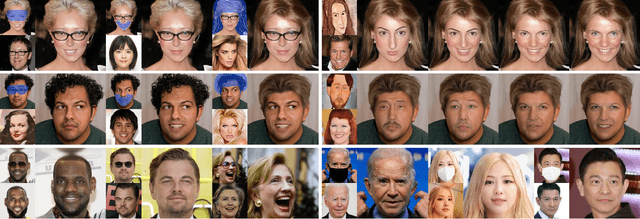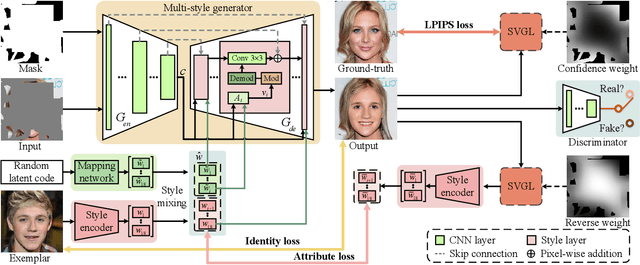Kaijie Shi
GRIG: Few-Shot Generative Residual Image Inpainting
Apr 24, 2023Abstract:Image inpainting is the task of filling in missing or masked region of an image with semantically meaningful contents. Recent methods have shown significant improvement in dealing with large-scale missing regions. However, these methods usually require large training datasets to achieve satisfactory results and there has been limited research into training these models on a small number of samples. To address this, we present a novel few-shot generative residual image inpainting method that produces high-quality inpainting results. The core idea is to propose an iterative residual reasoning method that incorporates Convolutional Neural Networks (CNNs) for feature extraction and Transformers for global reasoning within generative adversarial networks, along with image-level and patch-level discriminators. We also propose a novel forgery-patch adversarial training strategy to create faithful textures and detailed appearances. Extensive evaluations show that our method outperforms previous methods on the few-shot image inpainting task, both quantitatively and qualitatively.
Diverse facial inpainting guided by exemplars
Feb 15, 2022



Abstract:Facial image inpainting is a task of filling visually realistic and semantically meaningful contents for missing or masked pixels in a face image. Although existing methods have made significant progress in achieving high visual quality, the controllable diversity of facial image inpainting remains an open problem in this field. This paper introduces EXE-GAN, a novel diverse and interactive facial inpainting framework, which can not only preserve the high-quality visual effect of the whole image but also complete the face image with exemplar-like facial attributes. The proposed facial inpainting is achieved based on generative adversarial networks by leveraging the global style of input image, the stochastic style, and the exemplar style of exemplar image. A novel attribute similarity metric is introduced to encourage networks to learn the style of facial attributes from the exemplar in a self-supervised way. To guarantee the natural transition across the boundary of inpainted regions, a novel spatial variant gradient backpropagation technique is designed to adjust the loss gradients based on the spatial location. A variety of experimental results and comparisons on public CelebA-HQ and FFHQ datasets are presented to demonstrate the superiority of the proposed method in terms of both the quality and diversity in facial inpainting.
 Add to Chrome
Add to Chrome Add to Firefox
Add to Firefox Add to Edge
Add to Edge